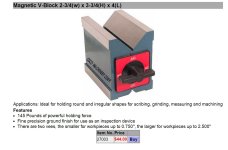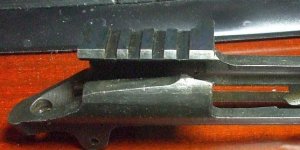Spongy soles do not work out!!Try hard soles and Merino wool sox.
Cutting oils do not have to be real complicated.Most home shop machines wil not be well set up for flood coolant.Mist coolant seems like a good idea till you notice you are breathing atomized coolant.
And intermittent coolant application thermally shocks the cutter.
At the risk of being obvious,saw the stock as close as you can to finish size without scrapping the piece.Usually 1/8 in will clean .Try to avoid milling 5/8 in of extra stock off.
To mill aluminum,a little spritz of WD-40 before the pass will work very well.You willlearn about climb milling versus undercut milling.Climb milling will ordinarily clear chips best,give the best tool finish,and cutter deflection will be in a material safe direction.HOWEVER!!!On a light machine,a loose machine,or taking heavy or aggressive cuts,the cutter can "get traction",hook up,overcome the drag of the table,and the cutter will move he mill table,not the feed.Generaly then your workpiece hits the wall with big chunks ripped out of it or the cutter breaks.You will know it when you see it!!Its good to check tram on your mill when that happens.OK,yeah,I DID learn a few things the hard way.
Steel....I dunno,some light cutting can be done dry,but I generally like a little lube.There is a difference between coolant and lube.An air blast can be a coolant and clear chips,but its not much of a lube.A little lube prevents galling,chips sticking.
Some of the tapping fluids like Tap Magic,etc work good on small gun part type milling.Not bigger jobs.
Get a gallon of water soluble oil concentrate.Look for the characteristics to not rust your machine.Long ago,there was Vantrol and Molecular Edge in various grades.Put it in a lab wash bottle .Good for milling and pretty good for most drilling.Just squirt a little as you need it.
Avoid drilling dry,in most materials.OK,wood you can drill dry.
Stuff like drilling and tapping a receiver,top grade tapping fluid makes a big difference.ReltonsRapid Tap is good.Oters may have a recommendation.
In a pinch,the old school black nasty sulphur cutting oil like plumbers use to thread pipe actually works pretty well on steel...but it smokes,stinks,and makes a mess.
WD-40 for Aluminum,A good steel tapping fluid..it may feel like dish soap,and a stock of water soluble will meet most needs.
OK,I'll tell you a secret one,but beware the obvious fire hazard.If you are going to have an aluminum part anodized,the oily stuff does not help.Denatured alchohol will work ,even for tapping.
Another idea on chips on the floor...keep a broom handy.Sweep them aside and they won't cut into your mats or shoe solesas much...its a percentage thing,you can cut it back 70% or so.
On Plexiglas:If you are going to drill it...be careful!!Plexiglas loves to have the drill bite in,especially as the point,or web of te drill breaks through.Brass has this same problem.The Plexiglas will usually just break when this happens.Darn it!! I'll try to describe what to do.Modify the drill.Cutter terminology: On the end of the drill,behind the cutting edge,you have CLEARANCE.It allows the cutting edge to contact thestock,so it can cut rather than rub.You have a clearance angle on lathe tools,on the sides.
We are not going to mod the clearance on the brass or plexiglass drill.
There is another cutter angle called RAKE.Mostly rake is the surface that directs the chip.Its on the top surface of a lathe tool.With a drill,it is the surface of the flute,back from the cutting edge.The normal rake is wedgelike to curl the chip away from the workpiece.Thats called a Positive Rake.In Plexiglass and brass,it acts like a screw thread and sucks the drill into the material.Then things go wrong.Whether you use the side of your bench grinder wheel,or a dremel,or a hard india stone by hand,Mod the drill by putting on a zero to slightly negative rake angle.Just put a little flat,.020 or .025,on the cutting edge face inside the flute,the length of the cutting edge.
The result is a small face of zero to slightly negative rake.
Another trick,if on a mill or drill press.Look to the spindle quill stop.Use it a lot!!It willhelp prevent scope base screws from protruding into the chamber.
You can also use it to control downfeed.Picture trying to drill a .020 dia hole through oh,1/2 in of stainless steel plate.Challenging,but doable.Use the quill stop to control the down feed.Put your thumb on it,and turn it a few thousandths,feed to the stop,back the cutter out,clear the chips,add oil,bring the drill back to the stop,advance the quill stop a few thousandths,etc.
Its particularly usefull breaking through the backside.Oh! Many steels will get hot at the drill tip as the wall thins breaking trough.Some stainlesses are bad!!
They harden!!You may end up burning your drill through.Always give a shot of coolant and ease of pressure breaking through.





